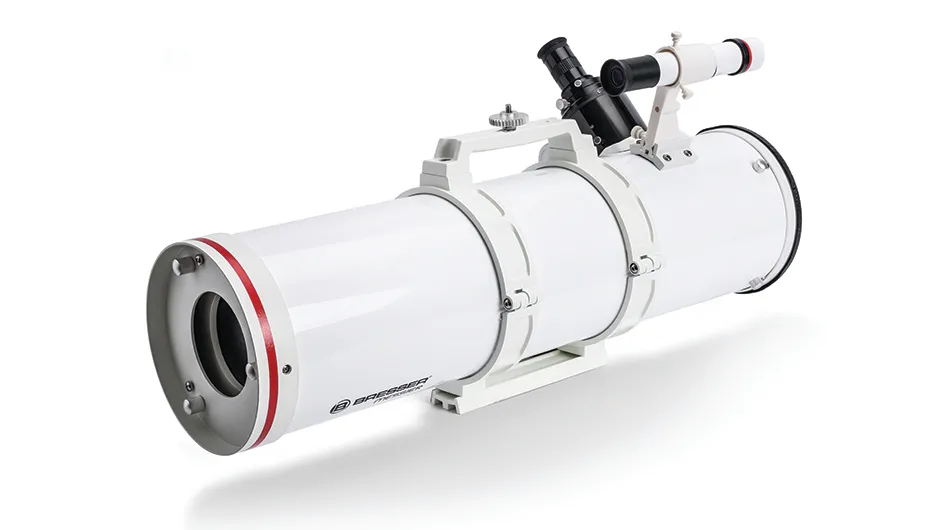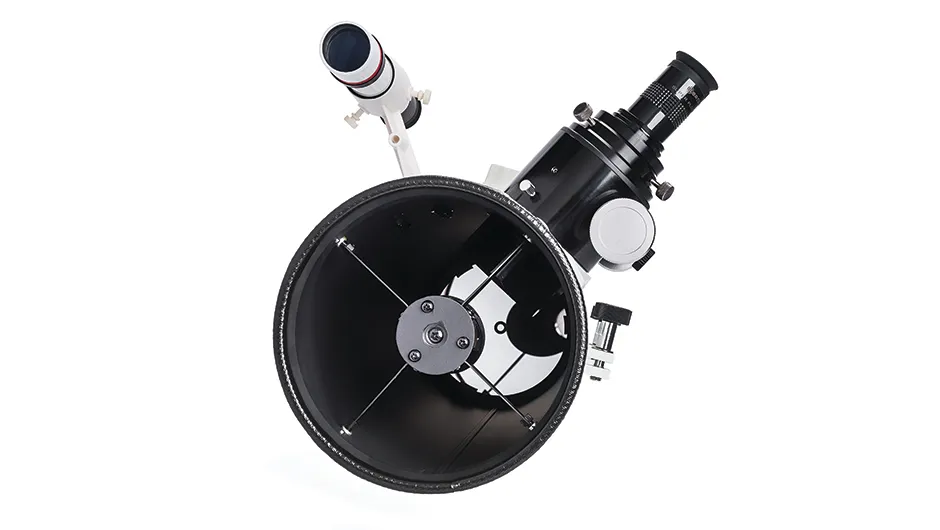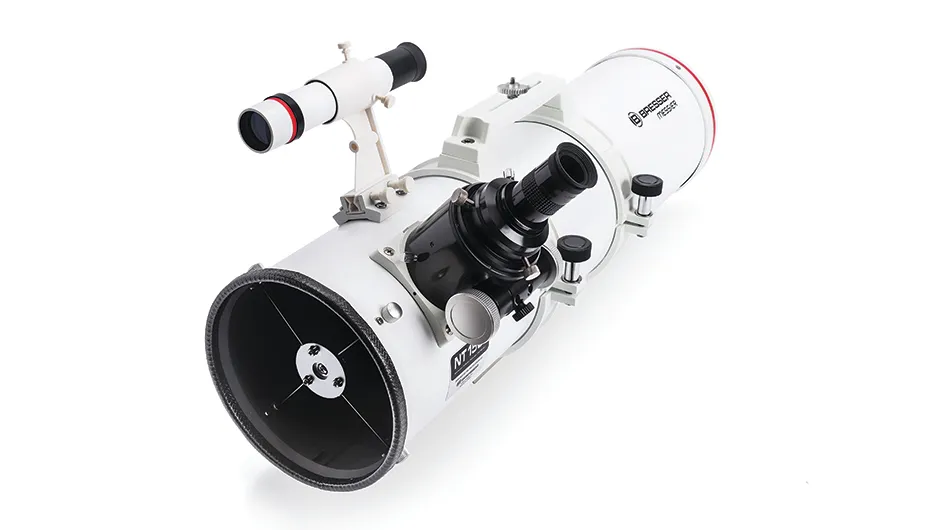Bresser has been updating and improving its range of Messier telescopes, many of which are now supplied with the 2.5-inch Hexafoc focuser, which can be single speed or, with a separately sold adaptor, dual speed.
Here we take a look at the Messier NT-150S reflector with the standard single-speed focuser.
The Messier NT-150S is almost entirely in white, with white tube rings that incorporate a white carry handle at the top and a white Vixen-style mounting bar underneath.
Bundled with the scope is a 6x30 finderscope, a focuser extension tube, a piggyback camera attachment, a 2- to 1.25-inch adaptor for the focuser and a 26mm Super Plössl eyepiece.
Also supplied is the freeware planetarium program Stellarium on a CD, a small planisphere and a basic set-up guide.
Reflectors are prone to having their optics misaligned in transit and when this scope arrived it did need to be recollimated.
This was achieved comparatively easily as the rear of the telescope has good-sized collimation knobs and easy to access adjustment screws.
For our tests we mounted the telescope on an NEQ6 mount, though you needn’t user such a heavyweight mount for an instrument of this size.
You could just as easily use an EQ3 or EQ5-style mount, or even an undriven altaz mount, for simple viewing.
With the focuser extension in place we used the 26mm eyepiece to achieve focus and them aimed at the bright star Capella in Auriga to check the field of view for quality.
Capella was quite sharp across an estimated 80 per cent of the field – quite acceptable for this telescope.
Fast reflectors such as this f/5 system do tend to show some coma, which is where the stars towards the edges of the view begin to look like comets, but it didn’t detract from the views.

Pushing the optics
The supplied 26mm eyepiece allowed us to view the whole of the Sword of Orion from the star cluster NGC 1981 down to Iota Orionis.
The latter is a double star and by using a 2x Barlow lens in conjunction with the 26mm eyepiece we were able to easily split it.
We do like to push the optics so we moved over to the triple star Beta Monocerotis; with our own 9mm eyepiece and the 2x Barlow lens we could see all three pale blue stars in a lovely tight arc.
Deep-sky targets were also quite rewarding, with a good deal of nebulosity when we viewed the Orion Nebula through the supplied 26mm eyepiece.
The Trapezium Cluster at its heart sparkled and invited us to change to our 9mm eyepiece to give a crisper view of the four main stars.
In moments of steady atmospheric seeing conditions there was a hint of the two fainter stars in the cluster, which was rewarding to the eye.
At this magnification the background nebulosity was also mottled with subtle detail.
We then aimed the scope towards M45, the Pleiades cluster in Taurus, and with the 26mm eyepiece it was stunning sight, the faint Merope nebulosity visible with averted vision while the stars blazed away crisp and bright.
Our next targets were the galaxy pair M81 and M82 in Ursa Major, which both fitted in the view of the 26mm while M82 showed some structure along its central portion when we used the 9mm eyepiece.
The gibbous Moon was best seen with our 9mm eyepiece and it almost filled the view with crisp detail along the terminator.
Turning towards Jupiter, which lay above the Moon that night, using the 9mm we could make out four bands, polar haze and three of the Galilean moons.
For astrophotography, and to achieve prime focus, you have to remove the extension tube from the focuser.
The 2- to 1.25-inch adaptor is equipped with a T2 thread although you will need the appropriate adaptor for your DSLR.
We attached our Canon 50D DSLR and aimed at the Double Cluster in Perseus, and a little later at globular cluster M3, and were pleased with the results we obtained with quite modest exposures.
Overall this is a relatively inexpensive good 6-inch reflector and, with a suitable mount, can give plenty of pleasure.

Lightweight and versatile
The Messier NT-150S and its accessories weigh in at just 5.5kg, so it is quite lightweight and easy for most people to handle.
Indeed, you don’t need to mount it on a heavyweight equatorial mount to enjoy the views offered by the optics, as for simple viewing it works perfectly well on an undriven altaz mount such as a SKYTEE-2 or Altair Sabre.
This makes it worthy of consideration as a get up and go scope to take to a remote site if you want to take advantage of darker skies.
The tube rings were easy to loosen so you can adjust the tube if you need to bring the focuser and finder to a more comfortable viewing position, ideal if you opt for an altaz mount.
Add a suitable equatorial mount such as Bresser’s EXOS-2 and you have a portable system that can be used for either observing or astrophotography, with the option of piggybacking a camera on the carry handle.

Finder
The supplied 6x30 finder is plastic and attaches to the main tube with a plastic bracket, itself held to the holder on the tube by two plastic bolts.
Adjustment of the finder to the main optical axis is also by three plastic bolts.
Although keeping costs down, we felt the finder could have been better.
Tube rings
The tube rings gave good grip to the tube and the tightening knobs were easy to handle even with gloves in the cold.
They attach to a Vixen-style mounting bar and on the top have a useful carry handle, onto which a camera can screwed for piggybacking.
Optics
The 6-inch parabolic primary mirror appeared defect free with a central spot to aid collimation.
It gave good views of both planetary and deep-sky objects and can handle high magnification as well depending on sky conditions.
Rear Cell
Bresser has thought about how telescopes are stored when not attached to a mount.
The rear mirror cell support is inset well into the tube, allowing you to stand it on its rear end without affecting the collimation knobs.
The chunky collimation knobs allowed us to quickly make adjustments as needed.
Focuser
The Hexafoc focuser is a single-speed rack and pinion design, with the option to upgrade to a dual speed system.
The barrel diameter is a wide 65mm, which prevents vignetting with some larger wide-field eyepieces.
An extension allows eyepieces to come to focus and can be removed for prime focus for astrophotography.
Vital stats
- Price £183.00
- Aperture 150mm (6 inches)
- FocalLength 750mm (f/5)
- Weight 5.5kg
- Supplier Telescope House
- Telephone 01342 837098
- www.telescopehouse.com
This review originally appeared in the April 2016 issue of BBC Sky at Night Magazine.
